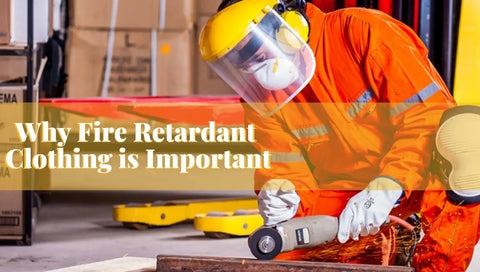This kind of uniform is worn in conjunction with a specialized tool kit based on the industry or manufacturer's need for safety in order to counteract the hazard associated with it. Proper administrative and engineering controls are put in place to minimize the possibility of a burn incident, with fire retardant clothing (FR), arc-rated (AR), personal protective equipment (PPE) serving as the final line of defence to reduce the severity of the injury if preventative measures fail.
The Distinction Between Fire Resistant and Fire Retardant Clothing Is as Follows:
These are the technical terms of reference that you encountered while looking for a uniform for your company due to the Fire Retardant Clothing kit.
Fire/Flame-resistant (FR):
The fabric material of fire resistant clothing is made of non-flammable fibres by nature. These materials have a chemical structure and are naturally flame resistant. The quality of such materials is that if they catch fire, they burn very slowly and self-extinguish to stop the spread of fire.
Fire/Flame-retardant (FR):
The flame retardant clothing material is non-FR fabric that has undergone a specific chemical procedure to achieve the inherent fire-resistant nature. The clothing is self-extinguishing and slow burning as a result of this chemical treatment. International standards must be met in order to manufacture this FRC raw material for fire and thermal protection. Cotton is the most commonly used baseline fabric in the manufacture of FRC.
Types of FR Clothing (kit):
The different kinds of fire-resistant clothing can be classified based on these general characteristics, which include uniform weight, level of protection, and garment design. The specifications for your FRC design must meet the protection standards for a manufacturing or industrial job type, as well as the hazard evaluation. The design look and feel are primarily determined by the garment you require as a base cloth.
Primary or secondary protection layers are the layers of fire-resistant clothing worn by workers who are constantly exposed to heat. Workers with partial exposure wear only one layer of FRC over their regular garments. Overalls and high-visibility garments such as jackets, bomber jackets, and coveralls protect the wearer from potential hazards. Balaclavas, face mufflers, and lab coats are also strongly suggested for professionals working in specialized fields.
Self-Extinguishing Properties to Reduce Burning:
The second layer of protection provided by FR/AR fabrics is their self-extinguishing properties. If a person is caught in a thermal incident, it is critical that the person's clothing does not continue to burn after the initial thermal event. Consider what would happen if a worker's clothes caught fire and burned after a thermal incident. The extent of body burns, or body burn percentages, worsen as the fire burns longer.
In the process, the flames can quickly spread to other parts of the body, causing more skin damage and jeopardising the body's largest protective organ. Self-extinguishing FR/AR garments reduce body burn percentages by not acting as fuel during thermal exposure.
Maintaining FR Clothing:
When purchasing FR clothing, keep in mind how the PPE will be maintained. Employers usually hire specialised laundry services for the job, and then conduct periodic checks to ensure the FR clothing is in good condition. Employers will need to provide appropriate training to their employees if they wash their own FR clothing. Improper laundering will severely damage the protective properties of the FR clothing and reduce its durability.
Even for naturally fire-resistant materials, most manufacturers advise against using chlorine bleach and fabric softener. Even if you allow your employees to wash their own garments, it is still recommended that you inspect the PPE on a regular basis to ensure it is fit for purpose.
How to Choose the Best Fire Resistant Clothing for Your Job?
When it comes to clothing, Fire-retardant shirts are available in many different colours and sizes ranging, available on selected colours only. Fire retardant shirts are intended to provide comfort as well as protection. Fire retardant shirts are ideal for use in jobs where flash or arc fires are a risk, such as gas and oil field work, welding, or even electrical work.
Also, FR pants are an essential piece of personal protective equipment, and they are necessary for category one and higher. The FR pants are all made of cotton and have triple-stitched seams. FR pants come in different types like jeans as well as cargo pants. Most people when it comes to FR pants prefer jean design.
Maintenance Requirements:
Fire-retardant clothing fabrics can only be washed so many times before losing their FR properties. There are also specific guidelines for laundering the fire-resistant clothing. For instructions, simply check the tag and follow the manufacturer's recommendations for proper care and maintenance.
Laundry instructions for fire-resistant clothing fabrics are also provided. But keep in mind that these clothes are made of materials that are naturally flame-resistant. As a result, they keep their quality much longer than treated fabrics.
Protection Level:
In terms of security levels, most different kinds of FR clothing include a label indicating the level of protection provided.
National Fire Protection Agency (NFPA):
The NFPA created this chart to assist workers in determining the level of protection required for their job. FR pants, shirts or jackets will have a label that indicates the Hazard Risk Category.
In general, lower-risk tasks only necessitate Category 1 or 2. Electrical workers are frequently required to wear at least a Category 3 respirator. Again, consult with your supervisor or the company's safety specialist to determine which rating you'll require for your job.
And Lastly, Comfort:
The perfect Fire Resistant clothing will not just keep you safe, but will also keep you extremely comfortable. Naturally, everyone's level of comfort will vary. The brand, the size, material, and other factors all play a role. If at all possible, request a sample from the vendor before making a purchase. You should make sure it is comfortable to wear on a daily basis.
Manufacturers can create soft as well as lightweight fabrics that are still protective and comfortable.
For those in industries that require enhanced safety measures, flame retardant workwear is essential. This specialized clothing is designed to protect workers from the risks of fire and heat exposure. With materials that self-extinguish upon contact with flames, it ensures safety in high-risk environments such as electrical, construction, and chemical sectors.






